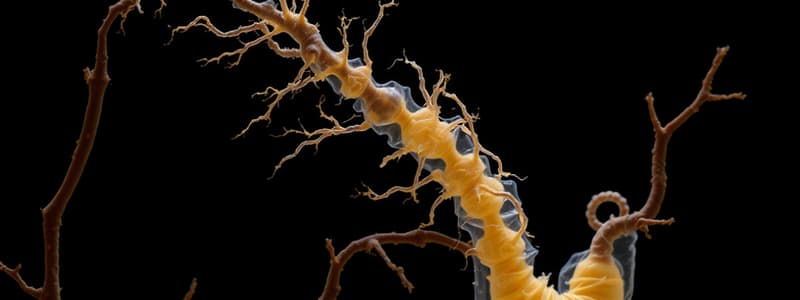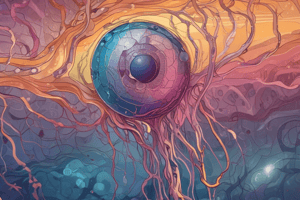Podcast
Questions and Answers
At what embryonic day does the formation of the neural tube occur?
At what embryonic day does the formation of the neural tube occur?
- 10th day of embryonic life
- 15th day of embryonic life
- 6th day of embryonic life (correct)
- 20th day of embryonic life
Which structure is associated with the telencephalon?
Which structure is associated with the telencephalon?
- Pineal gland
- Corpus striatum (correct)
- Hippocampus
- Cruc Cerebri
What is the primary significance of the neural crest cells during embryonic development?
What is the primary significance of the neural crest cells during embryonic development?
- Formation of the meninges
- Regulation of neural tube closure
- Healing of neural defects
- Differentiation into various structures (correct)
Which of these conditions is related to abnormalities in neural tube formation?
Which of these conditions is related to abnormalities in neural tube formation?
The development of the functional columns in the brainstem is associated with which embryonic stage?
The development of the functional columns in the brainstem is associated with which embryonic stage?
What does the rhombencephalon develop into?
What does the rhombencephalon develop into?
Which structure is NOT a part of the formation sequence of the neural tube?
Which structure is NOT a part of the formation sequence of the neural tube?
Which part of the brain is primarily formed by lateral diverticula during development?
Which part of the brain is primarily formed by lateral diverticula during development?
What is the main characteristic of mitotic activity in neural tissue at birth?
What is the main characteristic of mitotic activity in neural tissue at birth?
Which statement accurately describes the origin of motor nuclei in the brainstem?
Which statement accurately describes the origin of motor nuclei in the brainstem?
How does nervous tissue continue to develop after birth?
How does nervous tissue continue to develop after birth?
What type of tumors are pheochromocytomas, and what do they affect?
What type of tumors are pheochromocytomas, and what do they affect?
Which symptoms are commonly associated with pheochromocytomas?
Which symptoms are commonly associated with pheochromocytomas?
Where do most pheochromocytomas occur?
Where do most pheochromocytomas occur?
What is the main function of the alar plate in relation to sensory nuclei?
What is the main function of the alar plate in relation to sensory nuclei?
What is a significant misconception about neuron development at birth?
What is a significant misconception about neuron development at birth?
Which condition is associated with abnormalities in brain development leading to a smaller than normal cranial vault?
Which condition is associated with abnormalities in brain development leading to a smaller than normal cranial vault?
What is a potential consequence of abnormalities in the area around the sella turcica?
What is a potential consequence of abnormalities in the area around the sella turcica?
Which of the following is NOT a structure derived from the neural ectoderm?
Which of the following is NOT a structure derived from the neural ectoderm?
What is a common intellectual outcome associated with microcephaly?
What is a common intellectual outcome associated with microcephaly?
Which statement about ectoderm in the trilaminar embryo is correct?
Which statement about ectoderm in the trilaminar embryo is correct?
What can be a cause of microcephaly?
What can be a cause of microcephaly?
Which of the following describes the correct relationship between the sella turcica and pituitary health?
Which of the following describes the correct relationship between the sella turcica and pituitary health?
What is the significance of neural crest cells in embryonic development?
What is the significance of neural crest cells in embryonic development?
What condition might result from either overproduction of CSF or obstruction to its circulation?
What condition might result from either overproduction of CSF or obstruction to its circulation?
How do the lateral ventricles communicate with the third ventricle?
How do the lateral ventricles communicate with the third ventricle?
What structure connects the third ventricle to the fourth ventricle?
What structure connects the third ventricle to the fourth ventricle?
What happens to the cranial sutures when fluid accumulates in the lateral ventricles?
What happens to the cranial sutures when fluid accumulates in the lateral ventricles?
What factor is crucial for the proper circulation and reabsorption of CSF?
What factor is crucial for the proper circulation and reabsorption of CSF?
What is one potential consequence of failure in CSF reabsorption?
What is one potential consequence of failure in CSF reabsorption?
Which ventricular system component primarily resorbs CSF?
Which ventricular system component primarily resorbs CSF?
In extreme cases of hydrocephalus, what happens to the bones of the skull?
In extreme cases of hydrocephalus, what happens to the bones of the skull?
What is primarily responsible for the formation of cerebrospinal fluid (CSF)?
What is primarily responsible for the formation of cerebrospinal fluid (CSF)?
What structure connects the 4th ventricle to the spinal cord's central canal?
What structure connects the 4th ventricle to the spinal cord's central canal?
How much cerebrospinal fluid (CSF) is produced per day?
How much cerebrospinal fluid (CSF) is produced per day?
What is the primary function of cerebrospinal fluid (CSF) in relation to the brain?
What is the primary function of cerebrospinal fluid (CSF) in relation to the brain?
Which foramina allows cerebrospinal fluid (CSF) to leave the ventricular system?
Which foramina allows cerebrospinal fluid (CSF) to leave the ventricular system?
Where is the terminal ventricle located?
Where is the terminal ventricle located?
What provides a layer of protection for the cranial nerves against the skull?
What provides a layer of protection for the cranial nerves against the skull?
Which part of the brain's ventricular system is continuous with the 4th ventricle?
Which part of the brain's ventricular system is continuous with the 4th ventricle?
Flashcards are hidden until you start studying
Study Notes
Neural Tube Formation
- Neural tube formation begins on the 6th day of embryonic life and is complete by the 20th day.
- Neural crest cells develop concurrently, giving rise to various structures within the peripheral nervous system (PNS).
- Ectodermal placodes also form during neurulation, contributing to sensory systems.
Developmental Brain Regions
- Epithalamus includes the pineal gland, significant for melatonin production and regulating sleep-wake cycles.
- Telencephalon develops structures such as the corpus striatum, crucial for voluntary movement.
- Mesencephalon (midbrain) consists of the crus cerebri and corpora quadrigemina, involved in auditory and visual processing.
- Rhombencephalon (hindbrain) forms structures critical for motor control and regulatory functions.
Spinal Cord Development
- Histogenesis begins in the 5th week of embryonic life, establishing the neural tube's zones.
- Functional columns in the spinal cord develop from the lamina, organizing sensory and motor pathways.
- The fourth ventricle forms a continuous channel with the central canal of the spinal cord, subsequently labeled the terminal ventricle.
Cerebrospinal Fluid (CSF) Production
- CSF circulates through the brain's ventricular system, primarily produced by the choroid plexuses located in the lateral ventricles.
- Daily production of CSF is approximately 400-500 mL; it acts as a cushion, providing buoyancy to the brain and protecting it against injury.
- Pathologies, such as hydrocephalus, can arise from either overproduction or impaired absorption of CSF, leading to increased intracranial pressure.
Nervous System Cell Development
- All motor nuclei in the brainstem are derived from the functional columns of the basal plate, while sensory nuclei originate from the alar plate.
- Mitotic activity in neural tissue concludes during prenatal development, establishing a set number of neurons at birth, although continued growth and specialization occurs postnatally.
Clinical Correlations
- Anencephaly and rachischisis are critical neurodevelopmental defects associated with improper neural tube formation.
- Microcephaly, characterized by an abnormally small cranial vault, often results from genetic factors or prenatal insults, affecting brain growth and cognitive development.
- Pheochromocytomas are rare tumors impacting chromaffin cells, leading to excess catecholamine release; they can affect nearby structures causing complications such as hydrocephalus.
Ectodermal Structures
- Neural ectoderm comprises:
- Neural tube, eventually forming the central nervous system (CNS).
- Neural crest cells, leading to development of the peripheral nervous system.
- Ectodermal placodes, contributing to cranial nerves and sensory structures, excluding endodermal placodes which relate to the autonomic nervous system (ANS).
- Understanding of ectodermal derivatives is essential for recognizing embryologic development pathways.
Studying That Suits You
Use AI to generate personalized quizzes and flashcards to suit your learning preferences.




